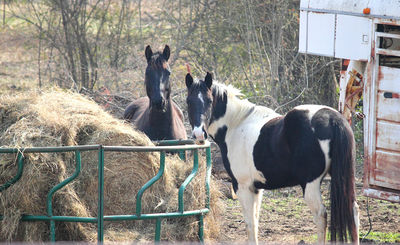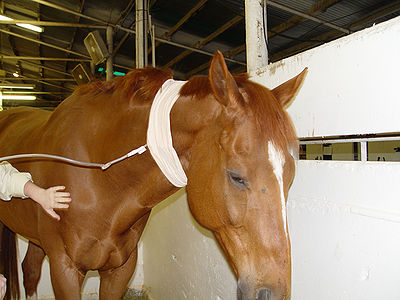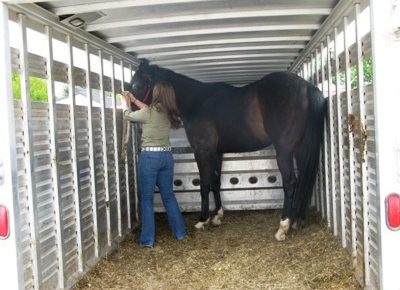
Following are some of the eyelid disorders that can occur in horses. With all diseases, early diagnosis and treatment can have a positive outcome.
Eyelid Lacerations – These are common with horses and usually heal. If surgery is necessary to repair a laceration, it can lusually be performed under local anesthesia.
Entropion and Ectropion – Entropion is when the eyelids roll inward. Ectropion is when the eyelids roll outward. They usually occur in young horses. Quickly repairing entropion avoids damage to the cornea from rubbing against it. Ectropion can be surgically repaired but isn’t necessary.
Eyelid Colomboma – This is a condition where the eyelid is missing either on the upper or lower eyelids. If it presents other problems, it can be corrected surgically.
Vitiligo is when skin loses its pigmentation. The cause is unknown and there is no treatment. The horse does not suffer any ill effects from this condition.
Trichiasis and Distichiasis – With Trichiasis the eyelashes are bent in toward the eye and rub the cornea. Distichiasis is the growth of extra eyelashes from the glands of the upper and lower eyelids. Both are corrected surgically.
Solar Blepharodermatitis is an inflammation of the eyelid due to sun exposure, usually on lids that have no pigment. It can cause redness and ulceration. Squamous Cell Carcinoma can result. Using products that are safe for horses to block the sun can help.
Parasitic Blepharoconjunctivitis – This condition occurs in the mucous membranes of the eyelid where parasites form granulomas. Granulomas are inflamed bumps on the skin. This can result in scratches to the cornea and local corticosteroids are the recommended treatment. Regular deworming and parasite control can help avoid the problem.
Mebomitis and Chelazion – Mebomitis is an inflammation of the mebomian glands at the eyelid edges that secrete lipid, part of the tear solution. Chelaz
Infectious Blepharitis is usually caused by trauma to the eyelid. Look for any foreign objects in the wound and surrounding area. Since abscesses could form, the infection should be treated with antibiotics.
Allergic Blepharoconjunctivitis – The cause is unknown but the results can easily be seen when the eyelid and surrounding tissue swell. Treatment is topical ointments and oral medications.
Mebomitis and Chelazion – Mebomitis is an inflammation of the mebomian glands at the eyelid edges that secrete lipid, part of the tear solution. Tear film bathes the cornea and is made up of 3 layers. The outer layer is lipid – a fat layer produced by glands in the eyelid edges. The middle and thickest layer is watery and is produced by the lacrimal gland and a gland at the base of the 3rd eyelid. The inner layer lies against the cornea and conjuctival surfaces and is produced by the mucous secreting gland of the conjuctiva. Chelazion is the thickening of the mebomian glands causing swelling and granulomas. Mebomitis is treated with topical corticosteroids and antibiotics. Granulomas due to Chelazion can rub against the cornea and should be removed surgically.
Periocular Sarcoids – Suspected cause of sarcoids may be a virus. There are several types of sarcoids that can be found on a horse’s body. The occult type in the eye area is flat, hairless, dry crusting dark patches. Warty sarcoids are irregular flat areas with skin thickening. Fibroblastic sarcoids are more aggressive and tumor-like in appearance. They bleed easily and can become ulcerated. Nodular sarcoids are benign. Sarcoids can be found in combinations. Treatment depends on the type of sarcoid and location. Prognosis is varied.
Eyelid Melanoma – Grey horses are prone to these tumors. Options for treatment are radiation, cisplatin injections, certain creams prescribed by your veterinarian. However treatment is not always successful.
Mast Cell Tumors – Mast cells are a part of the body and are found throughout the body. The tumors are formed by clusters of mast cells. Diagnosis is through biopsy. Some tumors in the eye area may be surgically removed.
Squamous Cell Carcinoma – This is an invasive cancer that must be diagnosed and treated early for a good outcome. Treatment can be with drugs or cryotherapy. Surgical removal is a last resort.
Ptosis and Horner’s Syndrome – A drooping upper eyelid is called ptosis. It usually occurs with head trauma and can be accompanied by facial paralysis. Horner’s Syndrome is a sympathetic nerve paralysis caused by an existing disease. Ptosis can be found in horses with Horner’s Syndrome. The disease causing the problem should be diagnosed and treated.
Related Articles



